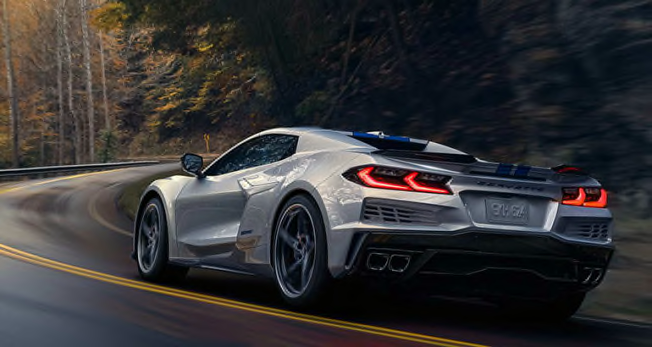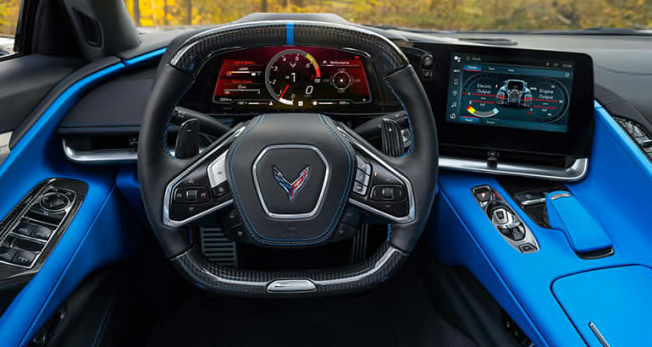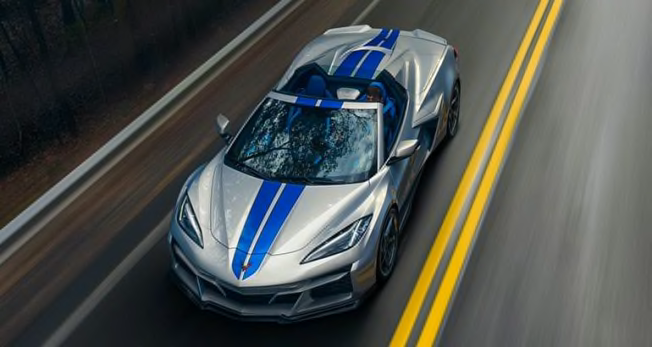Stunning 2024 Chevrolet Corvette E-Ray Combines Hybrid and AWD
This electrified version marks the sports car’s 70th anniversary

The Corvette is getting a hybrid version, part of a continuing trend of legacy automakers electrifying their existing fleets. Commemorating the Corvette’s 70th anniversary is the E-Ray, a hybrid version that builds upon the V8 powertrain in the Stingray by adding a front motor (and consequently all-wheel drive) with a total output of 655 horsepower.
GM’s president, Mark Reuss, has said that a fully electric version will follow.
CR's Take
Back in 1953, the original Corvette was created as an American alternative to European sports cars, with its humble 150-hp inline six engine and two-speed transmission. Over the decades that followed the Corvette evolved, but it always remained a stylish front-engine/rear-drive performance coupe and roadster—until the 2020 model year.
Almost from the beginning, Chevrolet experimented with rear engine designs and prototypes, but it wasn’t until the current eighth-generation model that the established mechanical formula was thrown out the window. The reason: To raise performance further, Chevy said it had to move the engine to the rear, just like the world’s leading supercars.
And now Corvette is diverging even more from its roots with an electric motor and all-wheel drive. The combination promises a broader range of driving modes and the ability to have AWD. And it paves the way for an upcoming all-electric model. Even if the Corvette EV is based on a different platform, the concept of it will be familiar to enthusiasts before the car debuts.
The current Stingray is wildly entertaining, with its sonorous soundtrack, rambunctious personality, and tenacious grip. But competition keeps pushing performance cars to new heights. Even the 2024 Ford Mustang Dark Horse will have 500 hp. The continued march to the Z06 and beyond was inevitable. Kudos to Chevrolet for breaking with tradition to create a car that will build on the Corvette’s legacy.
Outside
The exterior is based on the wide-body Z06 (3.6 inches wider than the Stingray), giving the E-Ray a bolder, extroverted appearance that would fit in among Europe’s latest, head-turning supercars. E-Ray badges will further identify the car, which can be enhanced with optional black exhaust tips, carbon-fiber ground effects, carbon-fiber or aluminum wheel choices, racing-type stripes, and 14 body colors.
Befitting an AWD sports car, the E-Ray comes with ultra-high performance all-season tires on its staggered 20- and 21-inch wheels. Michelin Pilot Sport 4S ultra-high performance summer tires are optional. Like the Z06, the wider body also means these tires are significantly wider at the front and rear than the standard Stingray, a key contributor to traction.

Photo: Chevrolet Photo: Chevrolet
Interior
The E-Ray interior is available in seven colors, with three seat choices and two carbon-fiber trim packages. Among the options for personalization is a new Artemis Dipped interior that applies deep green tones to most surfaces.
Otherwise, this is essentially the cabin established in the Stingray, complete with the rather unique divider between the driver and passenger that’s festooned with climate control switches.

Photo: Chevrolet Photo: Chevrolet
What Drives It
Like the Stingray, the E-Ray has a 495-hp, 6.2-liter V8 matched with an eight-speed automatic transmission. But what sets it apart is an electric motor upfront, wired to a 1.9-kWh battery, that contributes up to 160 hp for a combined total of 655 hp.
This is a traditional hybrid that recharges the battery as the car is driven, recapturing energy during braking and costing. It’s not a plug-in hybrid.
Chevrolet claims the E-Ray can race from 0 to 60 mph in a scant 2.5 seconds when using launch control, putting it .1 second quicker than the mighty 670-hp Corvette Z06. That makes it the quickest production Corvette in history. For comparison, the automaker cites a 2.9-second time for the regular Corvette Stingray. Consumer Reports recorded 3.4 seconds with our Stingray.
The addition of all-wheel drive to the Corvette—the first-time in the sports car’s storied history—is certain to aid traction for launching and track-level handling. And it makes it more capable for four-season driving—with the appropriate tires.
Even with this added grip, the E-Ray isn’t significantly quicker than the base model and Z06. One factor that explains this is weight. The E-Ray is about 400 pounds heavier than the Stingray. Plus, it’s very hard to shave time when you get down to 3 seconds. (Conversely, incremental gains at that point don’t mean much beyond bragging rights in the real world.)
There are six driver-selectable modes to tailor the powertrain, steering, and active performance characteristics to the needs: Tour, Sport, Track, Weather, My Mode, and Z-Mode. There’s also a Stealth mode for silent running on electric power at speeds up to 45 mph.
The center infotainment screen can show the power output from the motor and engine; graph horsepower and torque over time like a dynamometer; display energy efficiency, and show the status of the battery—important as you can use up the electric assist and need to let it recover before having the full 655 hp on top.
Chevrolet hasn’t hinted at fuel economy. Despite the fact that this is a hybrid, clearly the mission is performance, and electricity is the means to that end.

Photo: Chevrolet Photo: Chevrolet
Active Safety and Driver Assistance
Chevrolet says that like all Corvettes for 2024, the E-Ray will come with automatic emergency braking, lane keeping assistance, and lane departure warning. This is a big improvement over the 2021 Stingray we tested, where automatic emergency braking wasn’t available at all.
Stopping power is enhanced with Brembo carbon-ceramic disc brakes. Buyers should be aware that such track-oriented tech can add to maintenance.




















